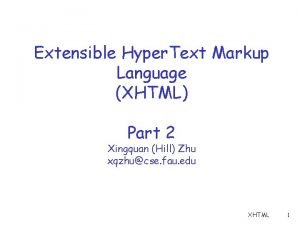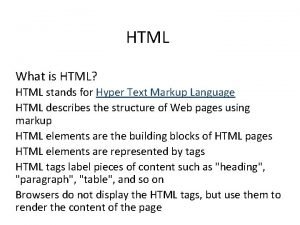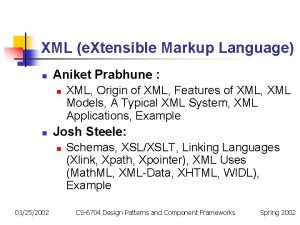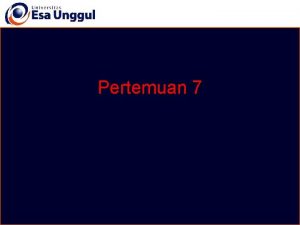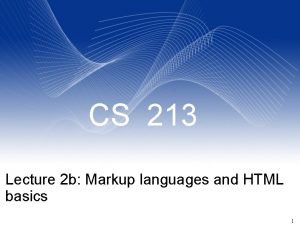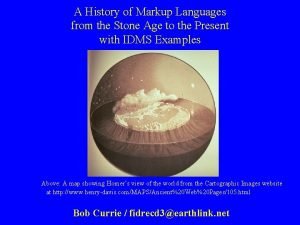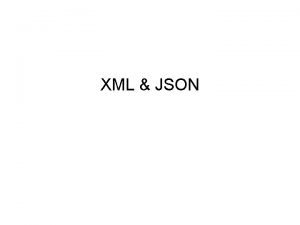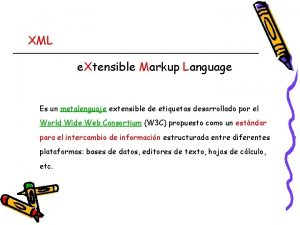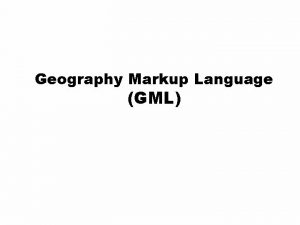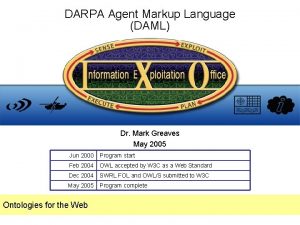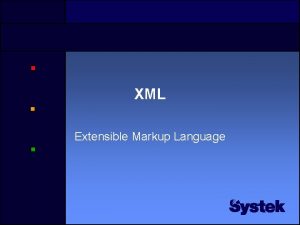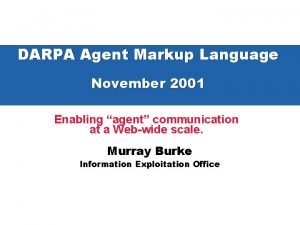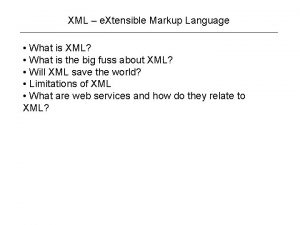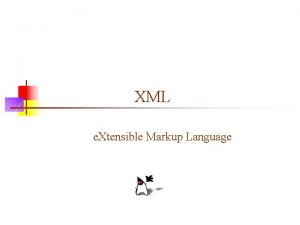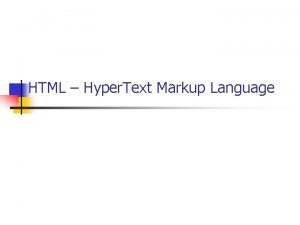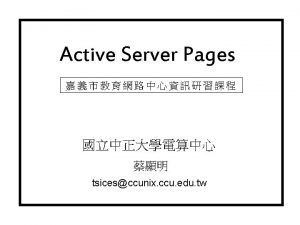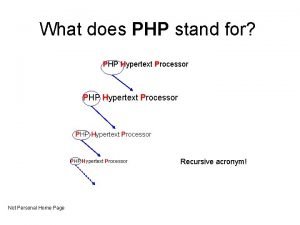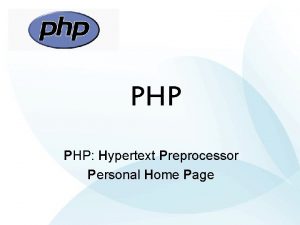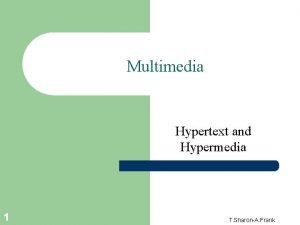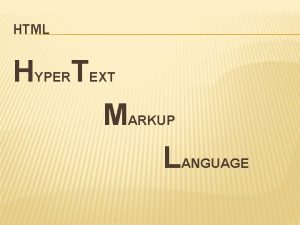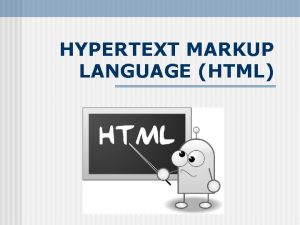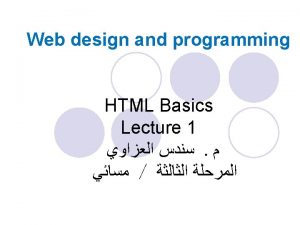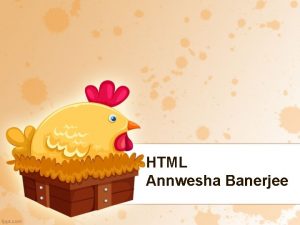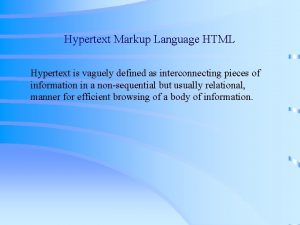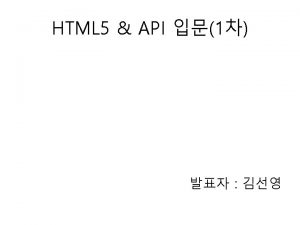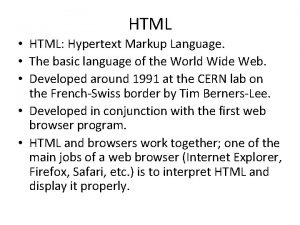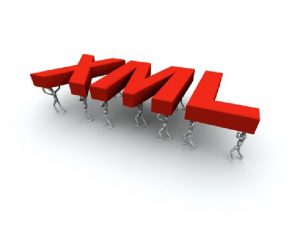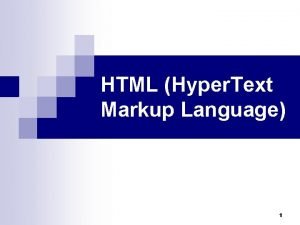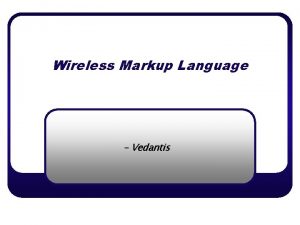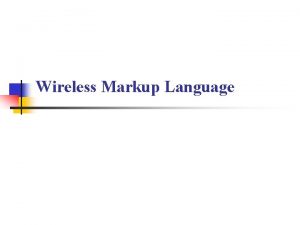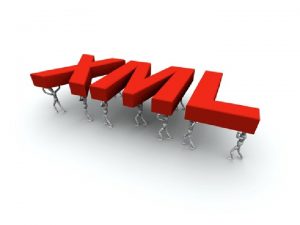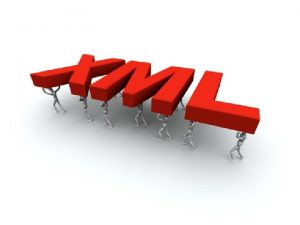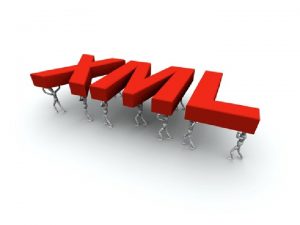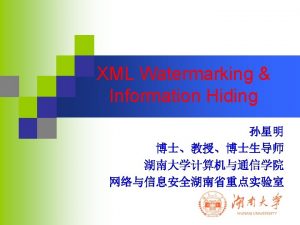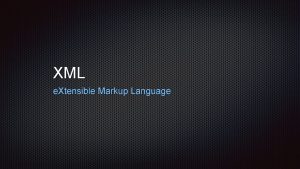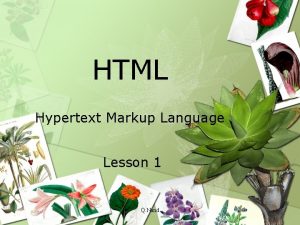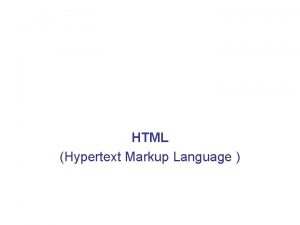Chapter 4 Hypertext Markup Language Primer TECH 1010


























- Slides: 26

Chapter 4: Hypertext Markup Language Primer TECH 1010 -02 Prof. Jeff Cheng

Describing a Web Page with HTML • Web pages are stored as a description of how they should appear on the screen • Web browser created the image from the description file written using HTML 3 -2

Marking Up with HTML Tags • Tags describe how a web page should look • Formatting with Tags: – Words or abbreviations enclosed in angle brackets < > – Come in pairs (beginning and end): • <title></title> – Tags are not case-sensitive, but the actual text between the tags is 4 -3

4 -4

An HTML Web Page File Begins with <html> and ends with </html> <head> Preliminary material goes here, including <title> … </title> </head> <body> Main content of the page goes here </body> </html> 4 -5

Tags for Bold, Italic, and underline • Bold: <b> </b> • Italic: <i> </i> • Underline: <u> </u> – Tag pair surrounds the text to be formatted • You can apply more than one kind of formatting at a time • <b><i>Veni, Vidi, Vici!</i></b> produces: Veni, Vidi, Vici! – Tags can be in any order, but have to be nested correctly • Some tags do not surround anything, so they don't have an ending form. Closing angle bracket is replaced by /> – <hr /> inserts a horizontal rule (line) – inserts a line break 4 -6

4 -7

4 -8

HTML Format vs. Display Format • HTML text was run together on one line, but displayed formatted on separate lines • HTML source tells the browser how to produce the formatted image based on the meaning of the tags, not on how the source instructions look • But HTML is usually written in a structured (indented) form to make it easier for people to understand <h 1>Pope</h 1> <h 2>Cardinal</h 2> <h 3>Archbishop</h 3> 4 -9

White Space • White space that has been inserted for readability – Spaces – Tabs – New lines • Browser turns any sequence of white space characters into a single space before processing HTML – Exception: Preformatted information between <pre> and </pre> tags is displayed as it appears 4 -10

Brackets in HTML: The Escape Symbol • What if our web page needed to show a math relationship like 0<p>r • The browser would interpret < p > as a paragraph tag, and would not display it • To show angle brackets, use escape symbol — ampersand (&) — then an abbreviation, then a semicolon (; ) < displays as < > displays as > & displays as & 4 -11

Special Characters • < < • > > • & & • (non-breaking space) • &mdash – (em dash) • Full list at http: //www. w 3. org/TR/REC-html 40/sgml/entities. html 4 -12

Attributes in HTML • Properties such as text alignment require more information • For justification, we need to specify left, right, or center • Attributes appear inside the angle brackets of start tag, after tag word, with equal sign, value in double quotes. Do not use “fancy/smart quotes!!!” <p align = "center"> (default justification is left) • Horizontal rule attributes: width and size (thickness) can be specified or left to default <hr width="50%" size="3" /> 4 -13

Marking Links With Anchor Tags • There are two sides of a hyperlink: 1. 2. Anchor text (the text in the current document that is highlighted) Hyperlink reference (the address of a Web page / target of the link) • Begin with <a followed by a space • Give the link reference using href="filename" • Close the start anchor tag with > • Text to be displayed for this link • End anchor tag with </a> <a href="target_of_the_hyperlink">Anchor Text Seen</a> Anchor Text Seen 4 -14

Anchor Tags (cont'd) • Absolute pathnames: Reference pages at other web sites using complete URLs http: //server/directory_path/filename <a href="http: //www. aw. com/snyder/index. html">FIT</a> 4 -15

Anchor Tags (cont'd) • Relative pathnames: Reference pages stored to the same directory (give only the name of the file) Read <a href=". /filename">this file</a>. – Relative pathnames are more flexible — we can move web files around as a group – Relative pathnames can also specify a path deeper or higher in the directory structure. /directory/filename. Current directory. . Parent directory (one level up) 4 -16 . . /directory/filename

4 -17

Including Pictures With Image Tags • Image Tag Format: <img src="filename" /> – src short for source – Absolute and relative pathname rules apply • Pictures can be used as links using anchor tag <a href="fullsize. jpg"><img src="thumbnail. jpg" /></a> 4 -18

Positioning the Image in the Document • By default, images are inserted in the page at the point where the tag is specified in the HTML, and the text lines up with the bottom of the image • Align attribute can line up image with top of line of text, middle, or bottom • Align left, center, or right attribute puts the image on the side of the browser window — text flows around it • To put image on separate line, enclose within paragraph tags • Can specify how large the image should be displayed (in pixels) with height and width attributes 4 -19

Handling Color • Color is used for both background and text • bgcolor attribute of body tag gives solid background color – Use hexadecimal color numbers (0 -9 A-F) <body bgcolor="#FF 00 FF"> (magenta) – Or use predefined color terms <body bgcolor="magenta"> • color attribute can be used with body text, link, or font tags <font color="red">text</font> 4 -20

4 -21

4 -22

4 -23

4 -24

Handling Lists • Unnumbered (bulleted) list: – <ul> and </ul> tags begin and end the list – <li> and </il> tags begin and end the items within the list • Ordered (numbered) list: – <ol> and </ol> tags begin and end the list – Uses the same <li> tags • Sublists: Insert lists within lists (between <li> </li> tags) • Definitional list: – <dl> and </dl> tags begin and end the list – <dt> and </dt> surround the terms to be defined – <dd> and </dd> surround the definitions (indented) 4 -25

Handling Tables • Tables begin and end with <table> and </table> tags • Rows are enclosed in table row tags, <tr> and </tr> • Cells of each row are surrounded by table data tags, <td> and </td> • Create a caption centered at the top of the table with <caption> and </caption> tags • Column headings are created as first row of table by using <th> and </th> tags instead of table data tags • See examples in textbook 4 -26
 Qtextarea
Qtextarea What html stands for
What html stands for Digi fiction examples in the philippines
Digi fiction examples in the philippines Language
Language Security assertion markup language definition
Security assertion markup language definition Wml format
Wml format Markup language examples
Markup language examples Clainlist
Clainlist E language
E language Lightweight markup
Lightweight markup Tecnica de la encuesta
Tecnica de la encuesta Geography markup language tutorial
Geography markup language tutorial What is gml
What is gml Darpa agent markup language
Darpa agent markup language Xml extensible markup language
Xml extensible markup language Darpa agent markup language
Darpa agent markup language Xtensible markup language
Xtensible markup language Language
Language Markup language
Markup language Verspeer
Verspeer Uiml
Uiml Markup language
Markup language Bandwidth extensible markup language
Bandwidth extensible markup language No tech assistive technology
No tech assistive technology What does php stand for?
What does php stand for? Personal hypertext processor
Personal hypertext processor Hypertext and hypermedia in multimedia
Hypertext and hypermedia in multimedia
